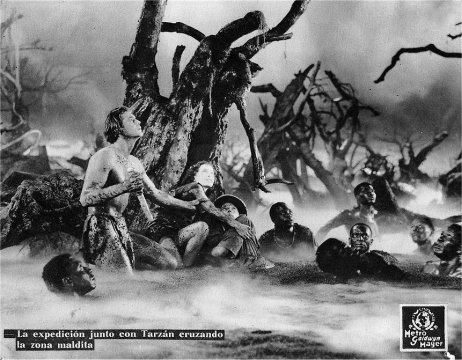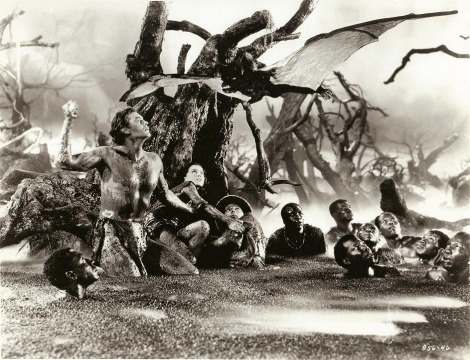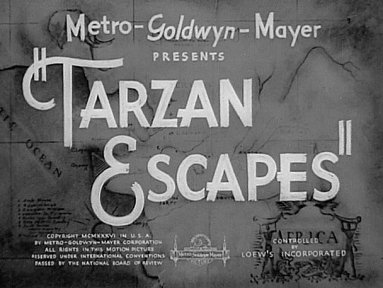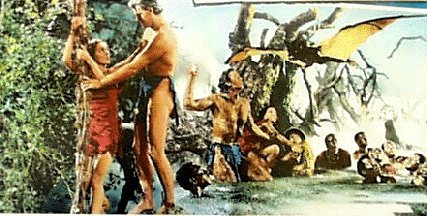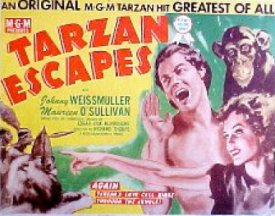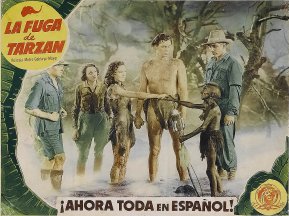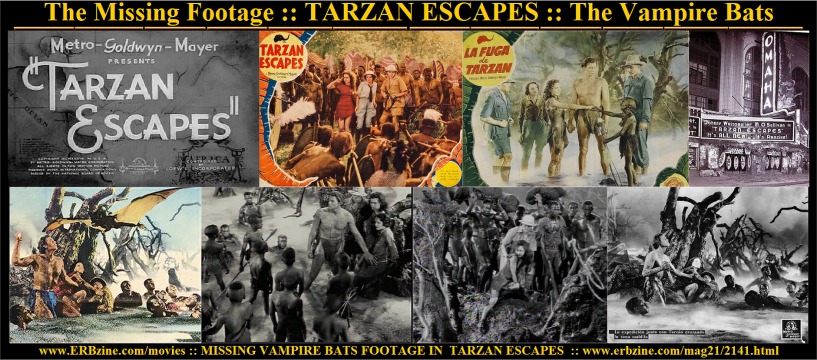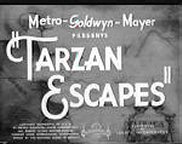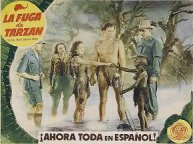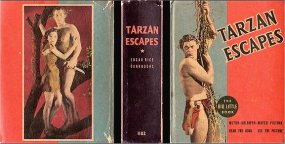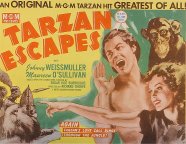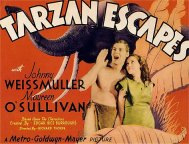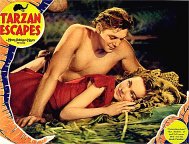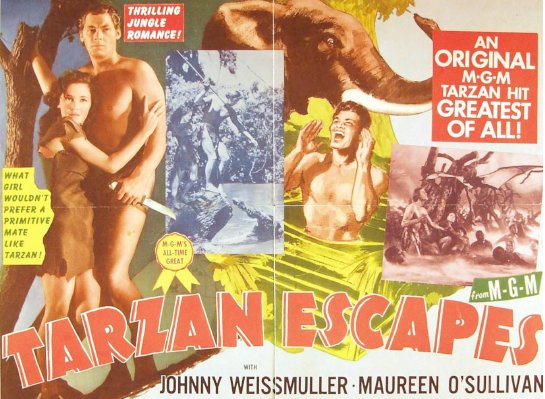 In
1954 I was frightened by the giant vampire bats in Tarzan Escapes.
I saw them in Madison, Wisconsin on a double feature with
Tarzan
the Ape Man. I was eight at the time. When you are young and scared,
you remember. The bat attack has stuck in my head like a nightmare that
can’t be resolved because the bats are lost.
In
1954 I was frightened by the giant vampire bats in Tarzan Escapes.
I saw them in Madison, Wisconsin on a double feature with
Tarzan
the Ape Man. I was eight at the time. When you are young and scared,
you remember. The bat attack has stuck in my head like a nightmare that
can’t be resolved because the bats are lost.
This famous lost action/horror scene has been discussed
at ERBzine Issue 0618,
by John McElwee at Greenbrier
Picture Show, and by Rudy Behlmer in "American Cinematographer" (1987)
and in the excellent TCM documentary, "Tarzan: Silver Screen King of the
Jungle."
Gabe Essoe writes in Tarzan of the Movies
(1968): "The Capture of Tarzan was finished in late 1935
and screened to preview audiences. The film terrified the children and
brought outraged complaints from irate mothers and women’s organizations.
It is important to remember that the
Frankenstein and Dracula
films made in this era were considered ‘adult’ films and not fit for children.
Afraid that if released in its present form, Capture would
be heavily criticized and alienate more people than it would attract, studio
bosses ordered all gruesome scenes cut and replaced with re-takes."
Despite all reports, I saw the vampire bats twenty years
after they were filmed. What exactly did happen? Can this mystery be solved
today? Can the bats be found?
In 1954 my family lived in a small town east of Madison.
Deerfield had no movie theater. We did not get television until 1953 and
MGM had not yet released any vintage films to TV. Although I had never
seen a Tarzan film before, they sounded exciting from the newspaper ad.
My parents were visiting relatives in Madison that weekend and dropped
me off at the kiddie matinee by myself. I was just old enough to go alone.
The next three hours delivered more adventure thrills than I had ever imagined.
Tarzan the Ape Man ran first. The pygmies
were disturbing. The giant ape that Tarzan fights in a pit was terrifying.
The elephant attack was breathtaking. It’s amazing that I can still recall
seeing these scenes for the first time, but every time I re-watch this
climax I get tinges of the original fear I felt at the first viewing.
Natives were killed, Jane’s father was mortally wounded, the ape looked
unbeatable and I truly feared they would all be killed. Had I been
just a year or two older and jaded with the certainty that heroes never
die, I might have thought “great ape costume” and left the theater with
no emotional memory of that day. This scene in Tarzan the Ape
Man survives intact, but my youthful fear also burned into my brain
scenes that I have never seen since.
Then came Tarzan Escapes. Near the end of
the film today, Tarzan, Jane and her two cousins, evil Captain Fry who
had caged Tarzan, and thirty or so natives enter a forbidden juju cave.
The treacherous path winds through dead trees and misty swamp. Jane comments:
"This is the first time in Africa I haven’t been able to see some sign
of a bird." Cheeta chitters at giant lizards that dart around in the bubbling
muck below. A native slips off the path, screams and vanishes in quicksand.
Jane also slips but cousin Eric pulls her back to safety. Two minutes after
entering they emerge into daylight at the other end. Fry comments, "Thank
heaven we’re out of the last!" One wonders at his relief until noticing
only about fifteen natives made it out alive. Tarzan forces Fry back into
the cave where he mysteriously dies in the swamp.
I saw more in the tunnel of terror. I saw the lost climax
of the entire film! Memory can be sketchy from long ago, so I have put
in italics any details I am not certain about. I would love to be corrected
by anyone with a better memory or when the lost scene turns up someday,
but until then this imperfect recollection should be of interest.
The safari treks deeper. Tarzan cautions everyone to
keep quiet. A shot of the high ceiling shows hordes of sleeping bats
hanging upside down -- really big bats. A native stumbles and kicks
a rock into the swamp or drops a pack. Noise! The bats wake and drop
down to attack. Bang, bang, bang! Rifle shots ring out, but not enough.
Natives poke and swat at the monsters with spears. Utter mayhem erupts.
A bat grabs one native and flies aloft with him. The victim flails and
screams as he is carried off to an unknown fate. More natives are carried
away in similar fashion. A bat grabs Jane’s shoulders and lifts her
skyward. She screams!
Either Captain Fry saves her with a well-placed
shot or Tarzan saves her with a spear. They run out of bullets and use
the three rifles as clubs in close combat until losing them.
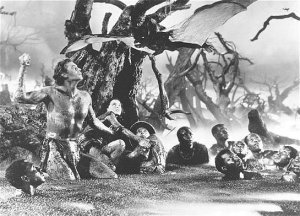 "Umgawa!"
Tarzan
begins pushing the survivors off the path into the swamp for their own
safety, or the bats knock them in. One-by-one everyone slides down
muddy banks into the muck below. This is scary because of the giant lizards
and killer quicksand, but the lucky ones find safe areas to stand and become
smaller targets waist deep in swamp. They try to slog along a hidden
path or huddle among the gnarled trees for meager protection. The air
attacks continue. More natives get sucked under quicksand. Tarzan flashes
his knife in hand-to-bat combat as depicted in that haunting still. He
manages to
"Umgawa!"
Tarzan
begins pushing the survivors off the path into the swamp for their own
safety, or the bats knock them in. One-by-one everyone slides down
muddy banks into the muck below. This is scary because of the giant lizards
and killer quicksand, but the lucky ones find safe areas to stand and become
smaller targets waist deep in swamp. They try to slog along a hidden
path or huddle among the gnarled trees for meager protection. The air
attacks continue. More natives get sucked under quicksand. Tarzan flashes
his knife in hand-to-bat combat as depicted in that haunting still. He
manages to
kill one, but there are too many more.
At the last minute a tribe of friendly pygmies arrives
carrying torches that scare away the bats. A Spanish lobby card shows
Jane thanking the pygmy leader in the swamp set, and a 1935 trailer gives
away that "a friendly pygmy tribe saves them." I confess that I only
vaguely recall pygmies showing up. I had seen pygmies in Tarzan the
Ape Man that day and they may have muddled together in my head.
The relief at being rescued had far less impact than the fear of death
by bats.
When Tarzan forces Fry back into the cave he picks up
a club for defense and ventures deeper. He deserves to die, but his bravery
somewhat redeems him. A bat swoops down and knocks him off the path
into the swamp of doom. The waters close over him. That felt like a
better death than to be flown off to the bat lair.
Maureen O’Sullivan comments in the Turner Classic Movies
documentary: "It was an awful, disgusting scene. There was a big swamp
and we were supposed to be going through this swamp with the safari, and
the mud was up to here, and the natives were all around, and we never got
a chance to go to the bathroom. At the end of the thing, oh, I was furious!
Then they cut it from the film so it was all a waste. It was in a swamp
and these bats were flying in. I would have thought they’d loved it, but
they didn’t."
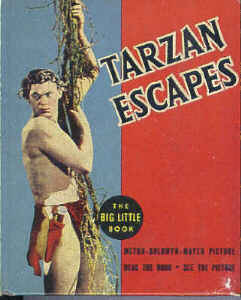 The
1935 version of Tarzan Escapes was finished and previewed
but is not known to survive. However, the Whitman "Big
Little Book" tells the 1935 story that never made it to theaters. The
cover proclaims "Read the book. See the picture." Included are 75 tiny
photos from the lost film. Among many surprising story lines, the safari
does not reach the top of the Mutia Escarpment until the middle of the
book. The elephants save everyone from a pack of lions. Jane and Tarzan
live in a cave. The tribe of Great Apes led by Timbee plays a central role.
Jane’s cousin Rita helps plot the capture of Tarzan and dies at the end.
Tarzan is rescued by Jane, Eric and Timbee on a river steamboat. The loss
of the unreleased 1935 film is unfortunate. Poor as it might have been,
who would not love to see new native, lion and crocodile attacks, or what
life was like inside Jane’s modern cave home? Or the bats in their original
story line?
The
1935 version of Tarzan Escapes was finished and previewed
but is not known to survive. However, the Whitman "Big
Little Book" tells the 1935 story that never made it to theaters. The
cover proclaims "Read the book. See the picture." Included are 75 tiny
photos from the lost film. Among many surprising story lines, the safari
does not reach the top of the Mutia Escarpment until the middle of the
book. The elephants save everyone from a pack of lions. Jane and Tarzan
live in a cave. The tribe of Great Apes led by Timbee plays a central role.
Jane’s cousin Rita helps plot the capture of Tarzan and dies at the end.
Tarzan is rescued by Jane, Eric and Timbee on a river steamboat. The loss
of the unreleased 1935 film is unfortunate. Poor as it might have been,
who would not love to see new native, lion and crocodile attacks, or what
life was like inside Jane’s modern cave home? Or the bats in their original
story line?
MGM was quite unhappy with the finished 1935 film. The
notion of Tarzan being rescued from bondage rather than him saving everyone
is insane, and that was the climax! The total misfire killed the careers
of producer Phil Goldstone and director James McKay. A dozen script doctors
consulted for months until the decision was made to remake the film with
a new plot. Herbert Mundin joined the cast for comedy relief, the tree
house was created, Timbee and his band of men in ape costumes were cut,
Fry became more of a villain when he shoots Mundin in the back, and action
sequences from the first two films were added. Cutting the vampire bats
was not considered at this point. The reasons for this view follow.
Rudy Behlmer in "American Cinematographer" cites studio
notes for the step by step remaking of the film in 1936, yet he ran into
a true mystery about the final fate of the bats: "Although this entry in
the series deliberately avoided or toned down the harsh, raw, Circus Maximus
accents so prevalent in Mate, a few bits -- most conspicuously
the attack of the vampire bats in the bog -- were eliminated before the
release. There is nothing in the Production Code Administration files at
the Academy of Motion Picture Arts and Sciences or studio records regarding
this, so it may have been as a result of adverse comments at previews.
MGM always had regarded this sequence as one of the few good aspects of
the first version of Tarzan Escapes, and it was included
in revised scripts...."
The bats may have gone into hiding, but they were not
eliminated. My speculation about the chain of events is based on an examination
of the film today, the promotional materials and the 1954 reissue.
The Big Little Book clears up two obscure swamp mysteries
that most viewers probably overlook. First: Why was Rita carried
into the cave on a litter, yet she walks out just fine? (Hint: It was not
the curative powers of the swamp mud!) The BLB tells us that in the 1935
film she fakes illness so Tarzan will take her back to civilization. She
is carried on a litter the entire trip until the bat attack makes her abandon
the ruse. In 1936 a new scene was filmed of Rita spraining her leg in the
escape from the Hymandis and being put on a litter. The only logical reason
was to match shots of her on the litter in the 1935 swamp footage that
MGM fully intended to include in the remake.
Second: How can all those dead trees be inside
a mountain where trees could not possibly ever grow? The amazing answer
is that in 1935 the safari never went inside a cave! The bats attacked
outside at night. A close look at the surviving swamp shows night clouds
in the distance rather than fog. Since the revised plot had the safari
escaping through the juju cave, new shots were filmed in 1936 of entering
and leaving the cave, plus the bats hanging from the ceiling and Fry’s
death. The footage of actually fighting the bats and the rescue by pygmies
was retained. MGM took elaborate steps to work these old scenes into the
new plot. In fact the bat attack might be the only footage salvaged from
1935.
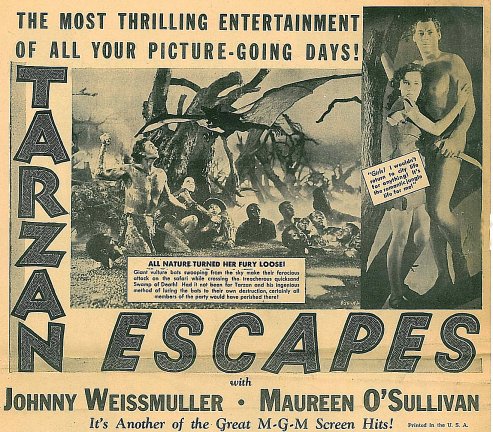 Returning
to my memorable double feature, there is a scene in Tarzan the Ape
Man where a lioness attacks Tarzan. After a bit of wrestling, he
kills it with his knife. Then her mate attacks! After great effort, some
blood and skillful editing between Weissmuller and the stuntman, Tarzan
kills it as well. When yet a third lion approaches, an elephant shows up
to protect him. This frantic, intense fight scared me as an eight-year-old
and remains in the film today.
Returning
to my memorable double feature, there is a scene in Tarzan the Ape
Man where a lioness attacks Tarzan. After a bit of wrestling, he
kills it with his knife. Then her mate attacks! After great effort, some
blood and skillful editing between Weissmuller and the stuntman, Tarzan
kills it as well. When yet a third lion approaches, an elephant shows up
to protect him. This frantic, intense fight scared me as an eight-year-old
and remains in the film today.
Thirty-five minutes into Tarzan Escapes,
Jane tells Tarzan to go get food. He swings through the trees, drops down
and kills a wildebeest. Then he is attacked by two lions in the exact same
footage from Tarzan the Ape Man that I had seen an hour before.
No elephant helps this time, but when the third lion shows up he escapes
to the trees with dinner. This was my first exposure to stock footage,
which is why I remember so vividly. I was scared twice by the same scene
on the same day. However, in the surviving version of Tarzan Escapes
these lion fights are missing. This is futher proof that the 1954 release
had more violence and action. Unlike the lost bats, the lion fights could
easily be put back into the film.
A third short sequence may have been cut because of violence.
After Tarzan is caged, some of Fry's natives transport him on a parallel
route so that Jane will not find out. Missing today is a scene where they
are brutally slaughtered by the Hymandis who then take over the cage with
Tarzan. I think I saw this but am not completely certain. The 1936 script
could verify that the scene was filmed.
Under Richard Thorpe's expert direction, MGM finally had
a slam-bang adventure epic with an action climax never seen before on the
screen and an emotional core about Jane needing to leave Tarzan. So what
happened to the vampire bats? It seems clear that the bat attack was considered
the best scene in 1935 and was turned into the action climax of the remake.
The bats were exploited to the hilt in the MGM Pressbook
that was sent to theaters several months before the release to help advertise
the film. The "Tarzan Display Goes on Tour" ad (in
the poster gallery) is from the press book. Note the phrase "At
press book time" and that details would follow. This indicates how
far in advance the publicity went out. The elaborate bat lobby display
is also featured in the pressbook. Hundreds had probably been printed
on heavy cardboard and were sitting in a warehouse waiting for theater
managers to order. Perhaps some theaters installed early and tantalized
their patrons with bats in the lobby for weeks in advance, as is often
done today.
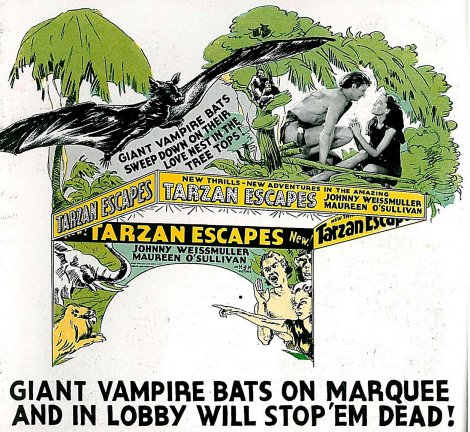
Sample "Heralds" were also sent to theaters early along
with the pressbooks. A Herald was a one-sheet flyer to be given away
in newspapers, at theaters and by cooperating merchants. The outside
would list the theater and playdates, while the inside folded out into
this double page ad. The caption on the sample Herald reads:
"ALL NATURE TURNED HER
FURY LOOSE! Giant vulture bats swooping from the sky make their ferocious
attack on the safari while crossing the treacherous quicksand Swamp of
Death! Had it not been for Tarzan and his ingenious method of luring the
bats to their own destruction, certainly all members of the party would
have perished there!"
Many, but not all, movie reviews cited the bats. Movies changed
three times a week in the 1930s and local reviewers rarely saw the films.
Instead they wrote about what would open Friday by reprinting promos from
studio pressbooks. This explains why a re-wording of the following studio
blurb appeared in paper after paper across the country in 1936:
TEN BIG THRILLS IN TARZAN
ESCAPES
.
-
The perilous safari into the Ju-Ju country and the attack
upon the white party by savages!
-
Tarzan’s seizure of Rita whom he swings through the treetops
to his jungle home!
-
The capture of Jane and Rita by the Ganeloni tribesmen and
the preparations for their torture!
-
Tarzan’s imprisonment in a cage by the cruel Major Fry, "bring
‘em back alive" animal collector!
-
The fall of the cage, containing Tarzan, over a cliff!
-
The freeing of Tarzan by friendly elephants!
-
The stampede of the Ganeloni tribe by the herd of elephants!
-
The adventure of the white party trapped in a quicksand mire!
-
The attack of the giant vampire bats!
-
Tarzan’s race for life in a crocodile infested river!
Tarzan does not swing Rita through the trees today, which
sounds like an excised scene from 1935. While he does fight one crocodile,
he doesn’t outrace them like in other films. The name Ganeloni was changed
to the Hymandis tribe. These errors cast doubt that the author had seen
the final cut, but newspapers printed the inaccuracies and Tarzan fans
came anyway.
So what happened? The classic Tarzan Escapes
was in the can. Advertising was in the mill. Expectations ran
high until MGM showed it to preview audiences. Another bizarre problem
struck the jinxed film -- it was now too thrilling for its own good!
Because of the Saturday Matinee serial The New Adventures of Tarzan
(1935), Tarzan films were now regarded as juvenile entertainment, but Tarzan
Escapes was not kid stuff. The horror elements were too scary.
(If only there had been a PG-13 rating system!) The 1936 previews
must be when kids reportedly "ran screaming from theaters," and a few mothers
screamed even louder. There was a huge uproar somewhere that was
not reported by the press, or the comment cards from the previews must
have been devastating.
MGM, embarrassed beyond words at this point, hastily and
quietly sent out censored prints. They cut the very climax they had
worked so hard to keep in the film. They cut the attack of the vampire
bats! There was no Hays office request to make the cuts, so the censorship
must have been self-imposed. The bat lobby display and the Herald were
never used. It was too late to prevent newspapers from mentioning the bats
that had been proudly ballyhooed in the pressbook, but no bats appeared
on theater screens.
Then came 1954 and plans to reissue the double feature.
Two negatives were sitting in the vaults, one a kind of "director's cut"
that must have been in better condition since it had hardly been used.
The decision was made to send out the bats and lion fights. Too scary for
kids? Too violent? Not anymore, not in the cold war era when killer bats
would sound like good clean fun. MGM at long last promoted the bats
in the newspaper ad that attracted me: "Giant vulture bats swoop from the
sky in a vicious air attack!" The 1954 half-sheet movie poster (22"x28")
I glanced at on the way into the theater shows Tarzan fighting a bat. The
entire audience was privileged to see one of the best Tarzan films ever,
just as MGM and director Richard Thorpe had intended after two years and
an enormous cost. Of course 90% of us were kids who did not appreciate
our good fortune! Nor did we suspect it might be both our first and
last viewing.
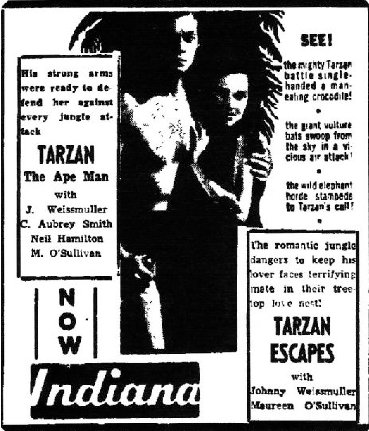 I
do recall preferring
Tarzan Escapes of the two films. Tarzan
the Ape Man plodded along while Tarzan and Jane got acquainted,
whereas
Tarzan Escapes had a lot more action. Besides the
vampire bats, elephant stampede and double lion fight, I was thrilled by
the Gaboni attack at the foot of the Mutia and the crocodile fight, both
lifted from
Tarzan and His Mate which I would not see until
years later. The strange disappearance of this ultimate 1954 version is
a great loss to Tarzan fans.
I
do recall preferring
Tarzan Escapes of the two films. Tarzan
the Ape Man plodded along while Tarzan and Jane got acquainted,
whereas
Tarzan Escapes had a lot more action. Besides the
vampire bats, elephant stampede and double lion fight, I was thrilled by
the Gaboni attack at the foot of the Mutia and the crocodile fight, both
lifted from
Tarzan and His Mate which I would not see until
years later. The strange disappearance of this ultimate 1954 version is
a great loss to Tarzan fans.
In the early sixties I was watching Tarzan Escapes
on TV and recall saying to my brother: “Oh, boy, here comes the good part!”
when the safari enters the cave. I had a long wait. The bats
had disappeared. They have never turned up on television or video
in the USA, nor been reported elsewhere. Since no one had seen them
in years, the false rumor soon grew that the bats had been scrapped as
far back as the 1935 previews. This is not the case. When the
MGM Tarzan DVD set came out in 2006, I became aware that the bats were
still missing. No one seemed to know they were in the 1954 release,
and beyond that, no one seemed to have ever seen them! Thus began
my quest to unravel the mystery of the lost bats.
One place the bats might have survived is in foreign language
prints. Different prints for different venues was a common practice
at the time in foreign markets that had diverse standards of acceptability.
Europe has always permitted or even desired more sex and violence than
studios could get away with at home. A perfect example is showing
the nude swimming scene in Tarzan and His Mate. If
the foreign versions of Tarzan Escapes had already been dubbed
when the sudden decision was made to censor the US release, they could
have gone out unchanged. The vampire bats may have been sent to Europe
and South America where there were no mothers' groups to object, while
the cut version may have gone to England which had restrictions on horror
and violence in the 1930s.
The 1954 Italian reissue movie poster showed Tarzan fighting
that bat, and the 35mm print may well have had the bats. Was it the
same print Italians saw in 1936? Since extra expense was involved
dubbing the film into Italian in either 1936 or 1954, one would expect
a dubbed master to be saved for eventual television release in Italy.
Lobby cards for the original Spanish language release
show photos from the lost 1935 film, like the scene of Tarzan putting Rita
on a litter before the trip. The same stills are in the Big Little
Book, which is how one can tell. This suggests that the version made
for Mexico, South America and Spain might have been dubbed in 1935 and
sent out as is, rather than waiting for the remake a year later.
This is a real longshot, but if true, then the complete first film in Spanish
with all those lost scenes and the vampire bats might yet surface.
It is more likely that the older stills from discarded scenes were put
on the 1936 lobby cards in error. Whichever is the case, the Spanish
theatrical version would be of great interest. Again, because of
the cost of dubbing into Spanish this master might have been archived for
later television broadcast. Has anyone seen Tarzan Escapes
on Mexican or Spanish TV?
I showed an early draft of this story to George Feltenstein,
a Warners/MGM archivist who has tracked down many lost scenes. He
enlightened me about reissue prints: "MGM had
two kinds of reissues in those days. There were a few titles that
got major national reissues, just like a new film. They very rarely
did this, but a few examples would be OZ in '49 or THE WOMEN
in '47. They would make several hundred prints for those engagements,
just as if it was first run.
"The 2nd kind of reissue was what
we would call a 'regional bicycle,' meaning they would bicycle prints from
one market to another. The regional reissues usually had around 60
prints made up, and they'd circulate them over a 12-18 month period.
Once the conversion from nitrate to safety occurred, the safety prints
made up for a reissue would move from the MGM exchanges on a frequent basis.
The reason why it is highly unlikely that any of the reissue prints of
TARZAN
ESCAPES would survive, is that I'm sure they would have used these
for kiddie matinees or sub-runs well past the initial major reissue.
"I do have an old print-out of the
MGM inventory from the early '70s that I often use for research.
Only major reissues were given a new release #, and it does show a "55"
series release number with REP next to the title for both TARZAN, THE
APE MAN and TARZAN ESCAPES, so that indicates something substantial.
Conversely, however, handwritten in this printout for TARZAN AND HIS
MATE are references to studio copies of 'long' and 'short' version,
whereas there is nothing indicated for TARZAN ESCAPES except nitrate
neg, safety neg, etc. Reading this old inventory is a heartbreaker,
because it represents the inventory before MGM sent their nitrate to Eastman
House, only to have most of it burn up there.”
In retrospect, it seems quite incredible that any film
would be made twice, have the best scene cut out at the last minute, then
be shown years later unheralded but complete, and then drop once again
into the black abyss of lost films. Yet that is exactly what happened.
The chain of events may be more clear now, but the central question remains
-- Where are the vampire bats? Do they exist anywhere on earth other
than in my memory?
Other Tarzan fans over sixty might have seen the bats
when I did in 1954. I have found one so far! John McElwee told
me: "I did ask my brother (born 1945 and nine years
older than me) if he saw the two Tarzans on reissue. He did, and
does remember the vampire bats. I don't think it was suggestive recall,
because I barely mentioned the content of the scene before he picked up
on it and described the sequence in some detail. I'm convinced he
saw the bats same as you did." I hope others will come forward
and share their memories.
My main goal is to inspire the film community to look
for the bats since there is more hope now of finding them. Was a
35mm safety negative struck in 1954 when the new release prints were run
off? Did one of the prints end up in private hands after its last theatrical
showing? When the Tarzan DVD set was being prepared, no one looked
for the bats since no one suspected they had survived into 1954.
The revelation that they were preserved on safety prints at that late date
has been incentive to launch a search. George and his archivist colleagues
have cheerfully accepted the challenge.
Every reader can help look. Ask foreign Tarzan fans
what they might have seen in theaters in the 1950s or on television.
I urge that every film print of Tarzan Escapes made before
1955 be examined. The bats might lurk on some 35mm print in a foreign
archive. 16mm prints from the 1930s and '40s made for small theaters
and the armed forces might also harbor the bats. Many 16mm prints
from this era are held by private collectors, and Tarzan is so collectible
that the existence of such a print is feasible. They could even be
in a video store in Italy! Take a look about ten minutes from the
end of the film when the safari enters the spooky juju cave. Do they
take a short walk to safety on the other side of the mountain as in the
surviving footage or do they battle unspeakable horrors from above?
Like the censored scenes in King Kong that
were lost for years and then restored, and like the nude swiming scene
in Tarzan and His Mate that was found overseas, the giant
vampire bats from
Tarzan Escapes may yet swoop down to carry
innocent victims off to their bat lair, while thrilling both Tarzan and
horror fans for the very first time!

